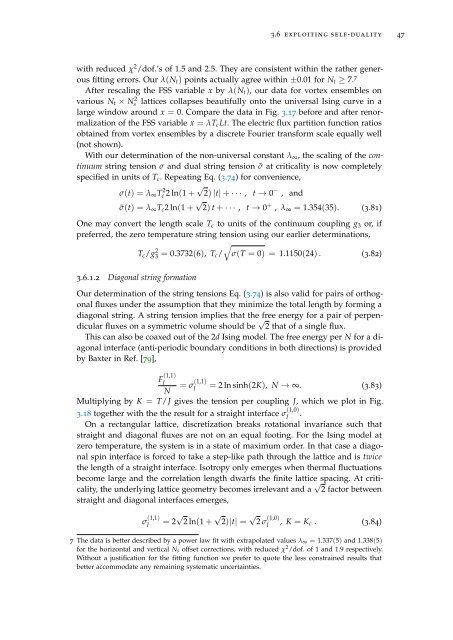Topology, symmetry, and phase transitions in lattice gauge ... - tuprints
Topology, symmetry, and phase transitions in lattice gauge ... - tuprints
Topology, symmetry, and phase transitions in lattice gauge ... - tuprints
Create successful ePaper yourself
Turn your PDF publications into a flip-book with our unique Google optimized e-Paper software.
3.6 exploit<strong>in</strong>g self-duality 47<br />
with reduced χ 2 /dof.’s of 1.5 <strong>and</strong> 2.5. They are consistent with<strong>in</strong> the rather generous<br />
fitt<strong>in</strong>g errors. Our λ(N t ) po<strong>in</strong>ts actually agree with<strong>in</strong> ±0.01 for N t ≥ 7. 7<br />
After rescal<strong>in</strong>g the FSS variable x by λ(N t ), our data for vortex ensembles on<br />
various N t × Ns<br />
2 <strong>lattice</strong>s collapses beautifully onto the universal Is<strong>in</strong>g curve <strong>in</strong> a<br />
large w<strong>in</strong>dow around x = 0. Compare the data <strong>in</strong> Fig. 3.17 before <strong>and</strong> after renormalization<br />
of the FSS variable x = λT c Lt. The electric flux partition function ratios<br />
obta<strong>in</strong>ed from vortex ensembles by a discrete Fourier transform scale equally well<br />
(not shown).<br />
With our determ<strong>in</strong>ation of the non-universal constant λ ∞ , the scal<strong>in</strong>g of the cont<strong>in</strong>uum<br />
str<strong>in</strong>g tension σ <strong>and</strong> dual str<strong>in</strong>g tension ˜σ at criticality is now completely<br />
specified <strong>in</strong> units of T c . Repeat<strong>in</strong>g Eq. (3.74) for convenience,<br />
σ(t) = λ ∞ T 2 c 2 ln(1 + √ 2) |t| + · · · , t → 0 − , <strong>and</strong><br />
˜σ(t) = λ ∞ T c 2 ln(1 + √ 2) t + · · · , t → 0 + , λ ∞ = 1.354(35). (3.81)<br />
One may convert the length scale T c to units of the cont<strong>in</strong>uum coupl<strong>in</strong>g g 3 or, if<br />
preferred, the zero temperature str<strong>in</strong>g tension us<strong>in</strong>g our earlier determ<strong>in</strong>ations,<br />
√<br />
T c /g3 2 = 0.3732(6), T c / σ(T = 0) = 1.1150(24) . (3.82)<br />
3.6.1.2 Diagonal str<strong>in</strong>g formation<br />
Our determ<strong>in</strong>ation of the str<strong>in</strong>g tensions Eq. (3.74) is also valid for pairs of orthogonal<br />
fluxes under the assumption that they m<strong>in</strong>imize the total length by form<strong>in</strong>g a<br />
diagonal str<strong>in</strong>g. A str<strong>in</strong>g tension implies that the free energy for a pair of perpendicular<br />
fluxes on a symmetric volume should be √ 2 that of a s<strong>in</strong>gle flux.<br />
This can also be coaxed out of the 2d Is<strong>in</strong>g model. The free energy per N for a diagonal<br />
<strong>in</strong>terface (anti-periodic boundary conditions <strong>in</strong> both directions) is provided<br />
by Baxter <strong>in</strong> Ref. [79],<br />
F (1,1)<br />
IN = σ(1,1) I<br />
= 2 ln s<strong>in</strong>h(2K), N → ∞. (3.83)<br />
Multiply<strong>in</strong>g by K = T/J gives the tension per coupl<strong>in</strong>g J, which we plot <strong>in</strong> Fig.<br />
3.18 together with the the result for a straight <strong>in</strong>terface σ (1,0)<br />
I<br />
.<br />
On a rectangular <strong>lattice</strong>, discretization breaks rotational <strong>in</strong>variance such that<br />
straight <strong>and</strong> diagonal fluxes are not on an equal foot<strong>in</strong>g. For the Is<strong>in</strong>g model at<br />
zero temperature, the system is <strong>in</strong> a state of maximum order. In that case a diagonal<br />
sp<strong>in</strong> <strong>in</strong>terface is forced to take a step-like path through the <strong>lattice</strong> <strong>and</strong> is twice<br />
the length of a straight <strong>in</strong>terface. Isotropy only emerges when thermal fluctuations<br />
become large <strong>and</strong> the correlation length dwarfs the f<strong>in</strong>ite <strong>lattice</strong> spac<strong>in</strong>g. At criticality,<br />
the underly<strong>in</strong>g <strong>lattice</strong> geometry becomes irrelevant <strong>and</strong> a √ 2 factor between<br />
straight <strong>and</strong> diagonal <strong>in</strong>terfaces emerges,<br />
σ (1,1)<br />
I<br />
= 2 √ 2 ln(1 + √ 2)|t| = √ 2 σ (1,0)<br />
I<br />
, K = K c . (3.84)<br />
7 The data is better described by a power law fit with extrapolated values λ ∞ = 1.337(5) <strong>and</strong> 1.338(5)<br />
for the horizontal <strong>and</strong> vertical N s offset corrections, with reduced χ 2 /dof. of 1 <strong>and</strong> 1.9 respectively.<br />
Without a justification for the fitt<strong>in</strong>g function we prefer to quote the less constra<strong>in</strong>ed results that<br />
better accommodate any rema<strong>in</strong><strong>in</strong>g systematic uncerta<strong>in</strong>ties.
















